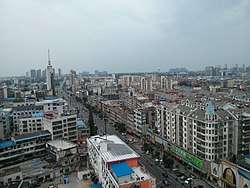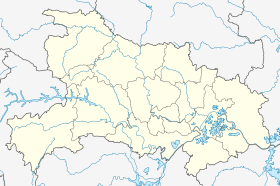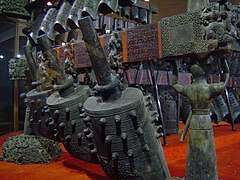Suizhou
Suizhou (simplified Chinese: 随州; traditional Chinese: 隨州; pinyin: Suízhōu), formerly Sui County (simplified Chinese: 随县; traditional Chinese: 隨縣; pinyin: Suí Xian, Suixian), is a prefecture-level city in northern Hubei province, People's Republic of China, bordering Henan province to the north and east.
Suizhou 随州市 Suichow | |
|---|---|
 Suizhou Qingnian Road Lieshan Avenue intersection, eastern view | |
.png) Location of Suizhou City in Hubei | |
 Suizhou Location of the city centre in Hubei | |
| Coordinates (Suizhou municipal government): 31°41′24″N 113°22′55″E | |
| Country | People's Republic of China |
| Province | Hubei |
| County-level divisions | 2 |
| Township-level divisions | 54 |
| Municipal seat | Zengdu District |
| Government | |
| • CPC Secretary | Ma Qingming (马清明) |
| • Mayor | Liu Xiaoming |
| Area | |
| • Prefecture-level city | 9,636 km2 (3,720 sq mi) |
| • Urban (2017)[1] | 266.00 km2 (102.70 sq mi) |
| • Districts[1] | 1,425.4 km2 (550.4 sq mi) |
| Elevation | 71 m (232 ft) |
| Population (2004) | |
| • Prefecture-level city | 2,580,000 |
| • Density | 270/km2 (690/sq mi) |
| • Urban (2017)[1] | 508,000 |
| • Districts[1] | 1,873,000 |
| Time zone | UTC+8 (China Standard) |
| Area code(s) | 722 |
| ISO 3166 code | CN-HB-13 |
| Website | suizhou |
Etymology
The Sui in Suizhou is derived from the ancient 'Suishizu' (随氏族) .[2]
Administration
The prefecture-level city of Suizhou administers 5 county-level divisions, including 1 district, 1 county-level city, 1 county and 2 other areas.[3][4][5]
- Zengdu District (曾都区)
- Guangshui City (广水市)
- Sui County (随县)
- Suizhou Economic Development Area (随州经济开发区)
- Dahongshan Scenic Area (随州大洪山风景名胜区)
These are further divided into 54 township-level divisions, including 36 towns, 11 townships and 7 subdistricts.
| Map |
|---|
Geography
| Climate data for Suizhou (Zengdu District, 1981–2010 normals) | |||||||||||||
|---|---|---|---|---|---|---|---|---|---|---|---|---|---|
| Month | Jan | Feb | Mar | Apr | May | Jun | Jul | Aug | Sep | Oct | Nov | Dec | Year |
| Average high °C (°F) | 7.5 (45.5) |
10.3 (50.5) |
15.0 (59.0) |
21.9 (71.4) |
26.9 (80.4) |
30.1 (86.2) |
32.0 (89.6) |
31.6 (88.9) |
27.8 (82.0) |
22.5 (72.5) |
16.1 (61.0) |
9.8 (49.6) |
21.0 (69.7) |
| Daily mean °C (°F) | 2.7 (36.9) |
5.3 (41.5) |
9.8 (49.6) |
16.3 (61.3) |
21.5 (70.7) |
25.3 (77.5) |
27.6 (81.7) |
26.9 (80.4) |
22.7 (72.9) |
17.0 (62.6) |
10.6 (51.1) |
4.8 (40.6) |
15.9 (60.6) |
| Average low °C (°F) | −0.8 (30.6) |
1.4 (34.5) |
5.6 (42.1) |
11.7 (53.1) |
17.0 (62.6) |
21.5 (70.7) |
24.2 (75.6) |
23.4 (74.1) |
18.8 (65.8) |
13.0 (55.4) |
6.5 (43.7) |
0.9 (33.6) |
11.9 (53.5) |
| Average precipitation mm (inches) | 26.9 (1.06) |
37.4 (1.47) |
59.2 (2.33) |
71.7 (2.82) |
120.1 (4.73) |
123.9 (4.88) |
195.9 (7.71) |
141.1 (5.56) |
67.1 (2.64) |
73.4 (2.89) |
41.0 (1.61) |
19.2 (0.76) |
976.9 (38.46) |
| Average relative humidity (%) | 74 | 73 | 74 | 75 | 75 | 79 | 83 | 82 | 77 | 76 | 75 | 73 | 76 |
| Source: China Meteorological Administration[6] | |||||||||||||
History

Suizhou has a long history. During the Spring and Autumn Period and Warring States Period (771−221 BCE), it was the territory of the State of Sui/Zeng and within the cultural sphere of the State of Chu. As a prefecture-level city Suizhou has a short history with its current status only granted by the State Council in June 2000.
Religion
The Catholic minority is pastorally served by its own (dormant?) pre-diocesan Apostolic Prefecture of Suixian (隨縣) which is exempt, i.e. directly dependent on the Holy See (and its missionary Roman Congregation for the Evangelization of Peoples), not part of any ecclesiastical province.
It was established on 1937.06.17 as Apostolic Prefecture of Suixian (隨縣) / Suihsien / Suihsienen(sis) (Latin adjective), on territory split off from the Apostolic Vicariate of Hankou (漢口).
It is vacant since 1951, without apostolic administrator since 1981, having had only the following incumbents :
- Father Patrick Maurice Connaughton (龔成德), Friars Minor (O.F.M.) (born Ireland) (1937.06.17 – retired 1951.03), died 1967
- Apostolic Administrator Friar Dominic Chen Te-mien, O.F.M. (1951.04.05 – 1981), no ther Ordinariate.
Transport
Suizhou is served by the Hankou–Danjiangkou Railway.
See also
References
- Ministry of Housing and Urban-Rural Development, ed. (2019). China Urban Construction Statistical Yearbook 2017. Beijing: China Statistics Press. p. 66. Retrieved 11 January 2020.
- 历史沿岸 (in Chinese). Suizhou People's Government. Retrieved 2018-12-13.
随州之“随”,其名最早源于远古的“随氏族”。
- 2016年统计用区划代码和城乡划分代码:随州市 [2016 Statistical Area Numbers and Rural-Urban Area Numbers: Suizhou City] (in Chinese). National Bureau of Statistics of the People's Republic of China. 2016. Retrieved 12 April 2018.
统计用区划代码 名称 421301000000 市辖区 421303000000 曾都区 421321000000 随县 421381000000 广水市
- 随州市行政区划 [Suizhou City Administrative Divisions] (in Chinese). Suizhou People's Government. 22 January 2016. Retrieved 12 April 2018.
下辖曾都区、随县、广水市、随州经济开发区、大洪山风景管理区
- 随州市历史沿革 [Suizhou City Historical Development]. XZQH.org. 7 December 2011. Retrieved 12 April 2018.
2000年第五次全国人口普查,随州市总人口2484688人。其中:曾都区1598752人、广水市885936人。{...} 2009年5月,国务院批准设立随县,以随州市曾都区部分乡镇为随县行政区域。7月29日,随县正式成立
- 中国气象数据网 - WeatherBk Data (in Chinese). China Meteorological Administration. Retrieved 2020-04-15.
Sources and external links
| Wikimedia Commons has media related to Suizhou. |
- Government website of Suizhou (in Chinese)
- GCatholic
